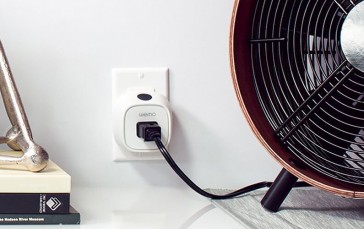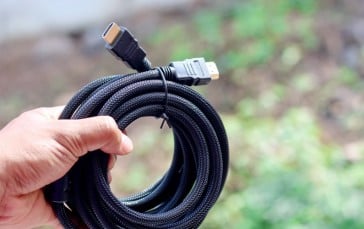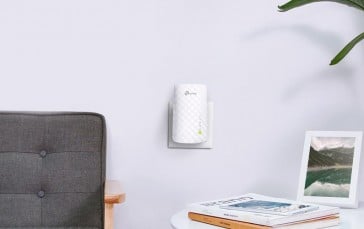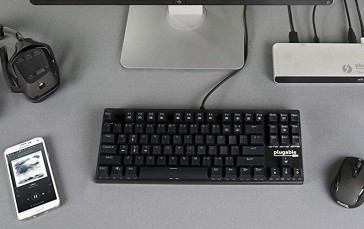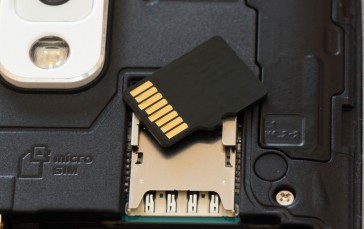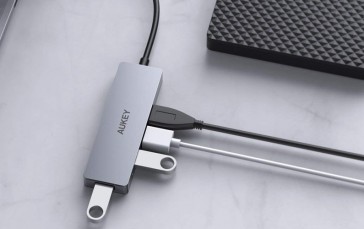Supercharge Your Network: The Best Ethernet Switches In 2022
Whether you’re an avid gamer looking to connect all your gaming and media PCs, or just someone who needs to connect multiple wired devices at your home or office like TVs, printers, and multiple computers, you need a good Ethernet switch. The best Ethernet switches are inexpensive and compact, and allow you to connect multiple devices to a single socket. Not to mention, they provide ultra-fast connectivity without the usual variables that can affect wireless networks, such as interference from other networks or devices, or thick walls or objects that can weaken the signal.
This is not to say that Wi-Fi doesn’t have its advantages: wireless networks are obviously more convenient than wired Ethernet cables and more than adequate for most of what we do on our networks. Still, if you want those Gigabit speeds for your devices (and there’s no doubt that the Ethernet cable is much, much faster than any Wi-Fi), you should go for an Ethernet connection.
To help you find the right Ethernet switch for your needs, we’ve rounded up some of the best models available on the market. We included both managed network switches and unmanaged Ethernet switches in our selection. For a business setting, you may want to get a managed Ethernet switch as you’ll have greater control over it, but for home use, a cheaper unmanaged network switch is perfect.
Without further ado, here are some of the best Ethernet switches you should focus on so you can build the home or office network of your dreams.
- Best Overall: NETGEAR GS1088-Port Gigabit Unmanaged Ethernet Switch
- Best Budget Option: TP-Link TL-SG105 5 Port Gigabit Network Ethernet Switch
- Best Budget Switch For Gamers: D-Link 8-Port Gigabit Ethernet Switch DGS-1008G
- Best Eco-Friendly Unit: TP-Link 16-Port Gigabit Ethernet Switch TL-SG1016
- Best Premium Pick: NETGEAR Nighthawk S8000 8-Port Gigabit Managed Switch
- Best Managed Network: D-Link EasySmart Gigabit Ethernet Switch DGS-1100-05
- Best POE Switch: Amcrest Gigabit Uplink 9-Port POE+ Ethernet Switch
- Best Value For Money: NETGEAR GS308 8-Port Gigabit Ethernet Unmanaged Switch
The Best Ethernet Switch
1NETGEAR GS1088-Port Gigabit Unmanaged Ethernet Switch

With a durable metal case and small footprint, the NETGEAR GS1088-Port Gigabit Ethernet Unmanaged Switch is possibly the best desktop switch for the unpretentious network builder who just wants to split a single connection between various devices. Its internet splitter provides connectivity to your modem or gaming router, allowing for additional wired connections. Be it an extra laptop, a printer, or your gaming console; this Ethernet switch can meet all your needs.
You’ll undoubtedly like the eight switched ports that provide bandwidth for your entire home or office, not to mention the ease of use. This switch impresses with its plug-and-play setup that requires no software or configuration. We also like its fanless operation that is truly quiet. Packing all you could wish from a best-in-class pick and coming with a lifetime warranty, this switch is no doubt one of your best choices.
8 Gigabit auto-sensing ports
Sturdy metal construction
Easy activity and speed monitoring
Lifetime warranty
- BrandNETGEAR
- ModelGS108-400NAS
- Weight1.97 Pounds
Port LEDs keep you informed of power status, link speed, and link activities
Auto-Uplink function adjusts for crossover or straight-through cables
Quick and easy set up
Ethernet switch supports jumbo frames up to 9KB
The switch doesn’t measure the power drawn by each PoE device
Weak security
2TP-Link TL-SG105 5 Port Gigabit Network Ethernet Switch
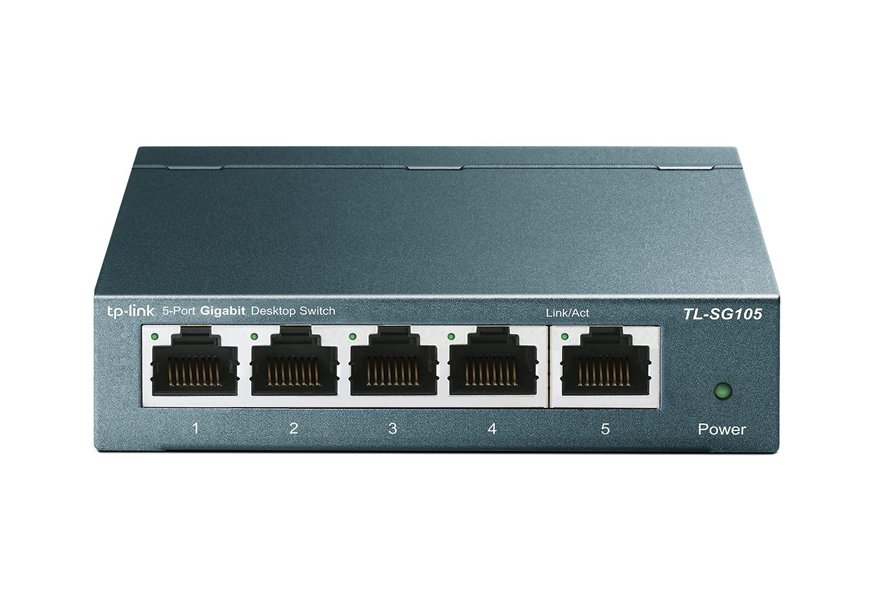
The TP-Link TL-SG105 is perhaps the best network switch to consider if you need only a few ports. This one has five and boasts a quick and easy plug-and-play setup that requires no software or configuration. With a desktop and wall-mounting design, you’ll also be able to find the most suitable installation arrangement. This Ethernet splitter ensures router or modem connectivity and incorporates auto-negotiation RJ45 ports developed to expand the network capacity. Moreover, the switch provides reliable data transfer and is perfect for gamers.
Another nice feature is the traffic optimization that enables smooth latency-sensitive traffic including video and voice. Perfect to install in your home office, living room, or even in the bedroom, this Gigabit Ethernet switch offers excellent value for money. Make sure you also check our guide to the best HDMI cables for more great products like this.
5 non-blocking gigabit ports
Plug and play setup
Traffic optimization
Power saving design
Desktop or wall-mounting installation
- BrandTP-Link
- ModelTL-SG105
- Weight12.8 Ounces
Network monitoring allows users to observe traffic behavior
Traffic prioritization and enhanced QoS
Optimized multimedia traffic delivery
Harder to configure than expected
The switch IP can’t be restricted or turned off
3D-Link 8-Port Gigabit Ethernet Switch DGS-1008G
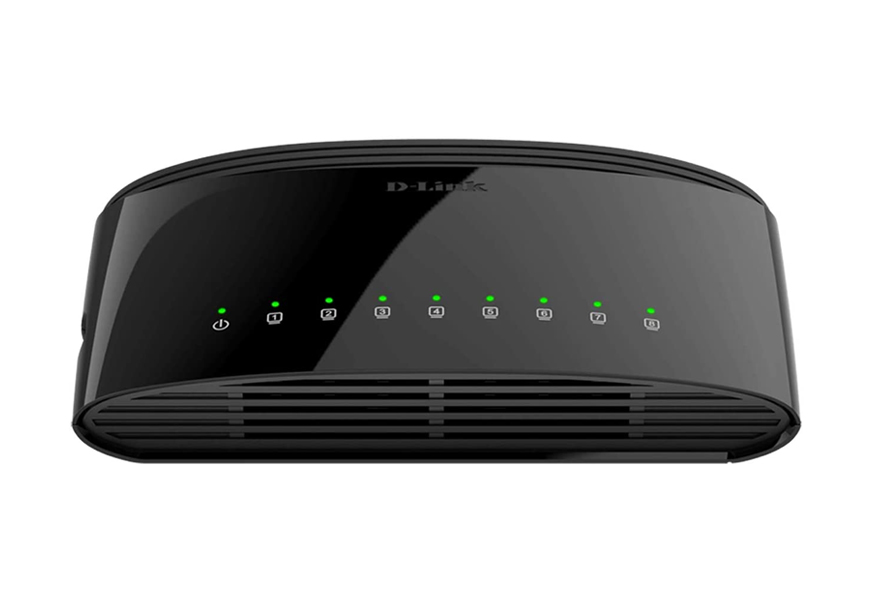
The D-Link 8-Port Gigabit Switch DGS-1008G is a perfect gift for gamers and anyone else who needs blazing Gigabit speed. It is designed to boost network performance and impresses users with a sleek design and unrivaled performance. This LAN switch boasts eight ports and won’t let you down when running bandwidth-demanding applications.
Like the other switches featured above, the D-Link DGS-1008G is a plug-and-play device that requires no software or configuration. Thanks to the hassle-free setup, this unit is great for beginners, and you can easily connect multiple computers to share files across your home or office network. Perfect for gamers on a budget, this switch can create the ideal gaming environment for multiple users and will never let you down due to poor performance or low speed.
8 Gigabit ports
Ideal for storage and gaming
Excellent functionality
Outstanding operational performance
- BrandD-Link
- ModelDGS-1008G
- Weight9 Ounces
Excellent switching capacity of 16 GB per second
QoS support for smooth online gaming and clear VoIP calls
Green Ethernet technology enhances energy savings
Supports Jumbo frames up to 9KB
This gigabit switch doesn’t have an outstanding lifespan
4TP-Link 16-Port Gigabit Ethernet Switch TL-SG1016
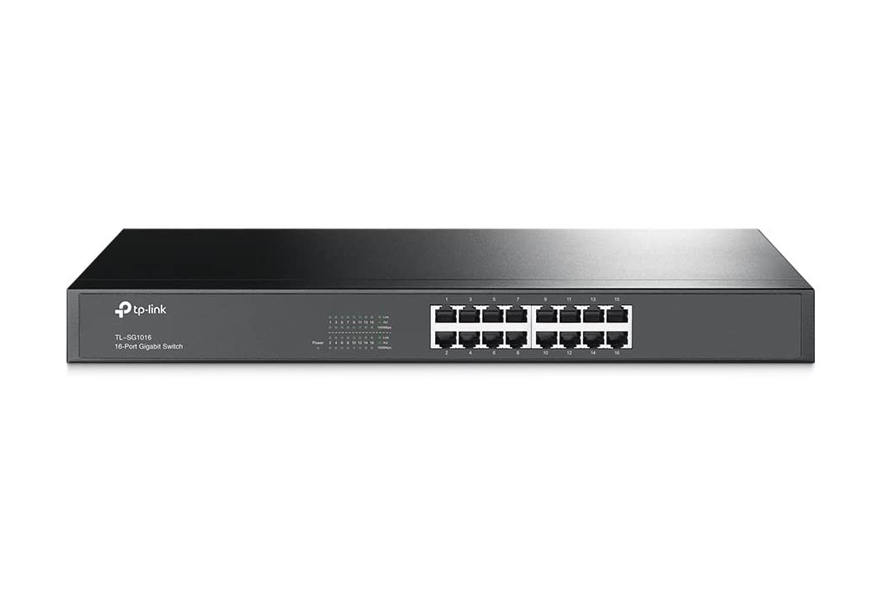
Gamers looking for a reliable and fast Ethernet switch able to provide instant large file transfers will love the TP-Link TL-SG1016. With a switching capacity of 32Gbps and 16 Gigabit ports, this apparatus is up to anything the network might throw at it.
Constructed with green technology in mind, the TL-SG1016 needs little power to expand your network capacity. It also adjusts its power consumption automatically according to your link status, reducing your energy consumption and carbon footprint. Installing the switch is a breeze as well thanks to the Plug and Play architecture. Furthermore, the auto MDI/MDIX eliminates the need for crossover cables. Intelligently adjusting for compatibility and maximum performance, this switch is perfect for a home network but would perform well in a business setting too. Be sure to also check out our list of the top smart plugs for more great items like this.
16 Gigabit ports
Non-blocking switching architecture
Instant large file transfers
32Gbps switching capacity
- BrandTP-Link
- ModelTL-SG1016
- Weight5.78 Pounds
The high capacity switch is ideal for home and office networks
Diagnostic LED indicators for network monitoring
Forwards data at full wire-speed thanks to non-blocking switch architecture
Plug and Play design simplify installation
Some complaints about poor customer support
Rack-mount hardware not included
5NETGEAR Nighthawk S8000 8-Port Gigabit Managed Switch

If you’re in the market for the absolute best Ethernet switch for gaming or office, make sure you check out the Netgear Nighthawk S8000 8-Port Gigabit Managed Switch. Yes, this one is far from inexpensive, but there are several good reasons for that. For one, the Nighthawk comes with an easy-to-use GUI interface that allows users to secure, configure and monitor their network traffic. Two, it boasts 8 Gigabit ports and is specifically optimized for gaming and streaming media, providing 99% lower latency than other more basic Ethernet connections.
This managed switch promises high-end performance and offers whisper-quiet operation thanks to its fanless design. It’s perfect for not only gaming but also for expanding your small business network while maintaining the transfer speed even when sending extra large files. This plug-and-play switch is seriously one of the best ones on the market, and the 3-year warranty speaks volumes about its quality. As a bonus, the Nighthawk is also sleek and good-looking which is not something that can be said about most Ethernet switches. Our handy guide to the top-rated WiFi extenders features more great products like this.
8 Gigabit ports
Cool-touch zinc-alloy housing
Management software
Gaming dashboard
3-year limited hardware warranty
- BrandNETGEAR
- ModelGS808E-100NAS
- Weight1.65 Pounds
Ultra-fast, ideal for gaming and streaming
Versatile, great for small businesses
Simple to use GIU interface
Tweakable via app
Stylish, modern design
One of the most expensive units
6D-Link EasySmart Gigabit Ethernet Switch DGS-1100-05
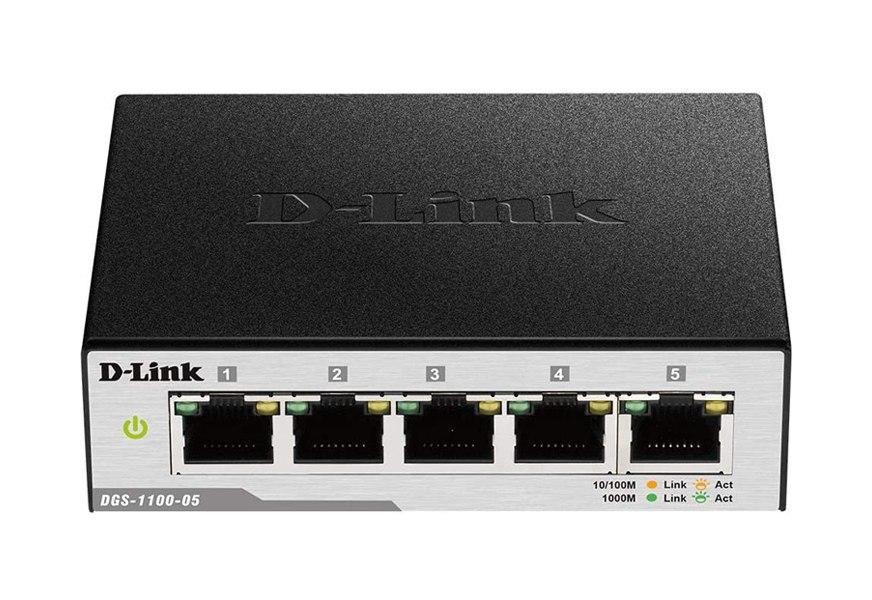
The EasySmart DGS-1100-05 is another affordable solution for small businesses and homeowners looking to expand their network. This device incorporates essential L2 switching features including Quality of Service and VLAN. A simple and intuitive management interface makes this switch hub ideal even for those who’re not really experts in building networks. Thanks to its energy-efficient compliance, you can also have peace of mind regarding your electricity consumption.
Quiet operation and lifetime warranty are two other features that may appeal to small business owners. The only downside is that your mounting options are rather limited. This switch has a desktop design and is not suitable to wall- or rack-mount. But if you don’t mind not having multiple mounting options, this is a fantastic baffordable managed Gigabit Ethernet switch. Find more great products like this by checking out our guide to the most popular surge protectors.
5 Gigabit ports
Support for 802.1Q VLANs
QoS traffic prioritization
Green technology for power saving
- BrandD-Link
- ModelDGS-1100-05
- Weight11.2 Ounces
Sleek, professional metal design
Network status monitoring lights
QoS prioritizes time-sensitive traffic
Some customers report the unit can sometimes reset to the default configuration
Not the greatest interface
7Amcrest Gigabit Uplink 9-Port POE+ Ethernet Switch

The Amcrest Gigabit Uplink AGPS9E8P-AT-96 is a 9-port POE switch that’s great for gamers, home users in general, and even some small business owners. It is unmanaged and gives you the ability to expand your network for up to eight POE devices. This switch is perfect for connecting IP cameras, gaming consoles, smart TVs and computers. Thanks to its plug-and-play design, you won’t have to worry about the configuration, while the compact desktop size allows you to place the switch even in a restricted space.
LED activity indicator lights allow you to monitor your network status and see which connected devices are active. At the same time, the SFP optical fiber uplink ensures that transfer speed is maintained in all circumstances. Packing useful features and boasting a long-lasting construction, this power over Ethernet switch is undoubtedly a great option. Don’t forget to also check our guide to the best USB flash drives.
9 POE ports
Plug and play configuration
LED activity indicators
Compact desktop size
- BrandAmcrest
- Weight2.75 Pounds
Excellent performance when used for IP cameras
Easy setup with no configuration required
Withstands high temperature operating environments
Construction could be more durable
8NETGEAR GS308 8-Port Gigabit Ethernet Unmanaged Switch

If you’re looking for an affordable ethernet switch, the NETGEAR GS308 is one of the most popular on the market. With over 11,000 five-star reviews, it’s one of the best products on this list to use on a day-to-day basis. The reason it’s so popular is that it’s affordable and doesn’t require any complicated setup. Just plug it in and enjoy an uninterrupted connection for your devices.
The NETGEAR GS308 has eight 10/100/1G ethernet ports, allowing you to plug multiple devices into your router. It features plug-and-play technology, so you don’t have to configure it or upload any software before you get started. Plus, it’s easy to mount to your desktop or even to the wall. We also like the fact that it comes with a three-year limited warranty, so you can trust the durability of the housing and connectors. Overall, a solid affordable Ethernet switch with enough ports for all your devices.
8 Gigaports
Plug and play configuration
Desktop or wall mountable
Three-year warranty
- BrandNETGEAR
- ModelGS308-300PAS
- Weight13.8 Ounces
Cost-effective
Easy to install
Works as advertised
No customer support
Runs hot
Why Trust Us
If anyone understands the benefits of wired networking, it's gamers and folks whose livelihood depends on good network speed, and Gear Hungry's got a lot of 'em. To give you the very best Ethernet switches, we've consulted with our researchers and editors and read dozens of Ethernet switch reviews, so you can rest assured you're seeing only the best of the best.
Who This Is For
This guide to the best network switches is for anyone looking for a speedier, more reliable network. Whether you have lots of devices at home you want to connect to your network like TVs and gaming consoles, or a small company with multiple computers and printers, there's a network switch here for you.
How We Picked
We read the literature, dozens of reviews, and compared the best-sellers. We also consulted with gamers on our team who let us know which Ethernet switches are their favorites and which ones are best avoided.

Features To Look For In Ethernet Switches
If you’ve ever run out of Ethernet ports on your router, you know the feeling of frustration that comes with it. Or maybe you want wired connections for all the devices in your home entertainment center, but don’t want to string multiple cables from the living room to wherever you happen to have your router.
An Ethernet switch is often the best way to extend your network and picking the best for your needs shouldn’t be too tricky. However, there are a few concepts you should understand first so you don’t buy the wrong switch or overspend needlessly.
Number of ports - The most important thing to figure out is how many ports you need. Think of how many devices you have to connect to your network. If it’s just a handful of them, you could easily get away with a five-port switch, which is perfect for wiring four devices plus connecting your switch to the router.
An eight-port switch is typically preferred by gamers who want to connect more than one computer – plus gaming consoles and other devices – to the network.
Unless you’re planning to use the Ethernet switch as the primary hub for all your devices, odds are you won’t need a 16-port or 24-port switch. However, such a device could be needed if you’re building an office network.
We found that most people prefer the eight-port switches in terms of both needs and budgets.
Speed - Depending on your needs, you can choose between two types of switches, those with Fast Ethernet and those with Gigabit Ethernet. We’re huge fans of the latter, as most routers come with Gigabit Ethernet ports anyway and it’s a pity to hamstring yourself by pairing it with a slower switch.
In broad terms, Gigabit is about ten times faster than Fast Ethernet. You may believe slower speed means a lower price. Even if this is technically true, you might not save enough to justify a poorer choice.
However, you should also consider the ISP plan you’re paying for. If your internet provider only gives you 50Mbps downloads, it’s unlikely you’ll notice any speed difference between a Fast Ethernet and a Gigabit Ethernet device.
You’ll still be able to stream music and 4K videos with Fast Ethernet, and you could save some coffee bucks. However, if you’re on a fast fiber network, there is a huge difference between the two types of switches, and you could use the ten times faster download velocity.
Quality of service - Quality of Service – or QoS – is another important feature you should consider. It lets you manipulate network traffic so that your switch can forward it in a manner consistent with the behavior required by the application generating the traffic. Thanks to this feature, your wired network will be able to differentiate traffic and prioritize it.
This feature is extremely important if you want to stream music or videos. A device without QoS will deliver data in a first-come-first-served fashion without prioritizing time-sensitive data packages. In other words, the quality of voice or video services could be affected.
However, if you’re a subscriber of such a service, you might demand acceptable levels of quality each time you want to use those services. And that’s where QoS steps in. This feature is able to prioritize traffic among a bunch of other technical things.
In simple words, QoS is as important to your network as the waiting place is to the McDonald’s Drive-Thru. If someone ordered $50 of stuff, they can sit and wait for their order to be ready; those who only want a coke can simply pass and get along with their business without waiting in line.
Managed vs. unmanaged switches - If you’re in the market looking for the best Ethernet switch, you have probably noticed there are managed and unmanaged devices. Which one is right for you pretty much depends on the type of network you’re creating.
Unmanaged switches are ideal for home users and anyone else with limited tech and IT knowledge. This type of switch is nothing but a simple hub in which you can plug in your devices. Once they are all connected, just put the switch somewhere and forget it exists. You won’t have to make any updates nor provide other types of input, as the switch will do its job smoothly and quietly all on its own.
Tech experts tend to prefer managed switches. These devices can do everything an unmanaged device can, but they also allow you to log into a web-based user interface or app to adjust some settings or update the firmware. Some of the things you can manage are the QoS rules, VLANs, or you can set up bandwidth limits.
However, keep in mind that managed switches cost more than unmanaged ones. Setting up your parameters could also be tricky if you’re not an expert. Furthermore, some managed switches tend to reset to factory configuration every now and then, so you’ll have to keep reconfiguring your device each time this happens.
Types Of Ethernet Switches
In broad terms, we can talk about two types of Ethernet switches, modular and fixed.
Modular switches – These give you all the expansion capabilities you need and are great for those looking to build a professional network. You can add more modules as your network grows without having to buy a new switch. These types of devices provide utmost flexibility but have exaggerated costs. Yes, the costs are justified by their complexity, but if you’re not planning to connect an entire neighborhood to your home network, a fixed switch could be a better starting point.
Fixed switches – These are not expandable, and almost all models designed for home or small business use stand in this category. Digging further into the matter, we can break down this category into unmanaged, partially managed, and managed switches.
We already discussed the managed vs. unmanaged switches above, but to sum it up:
- Unmanaged switches - They are the most commonly used switches in home and small business networks. They are less expensive, but they can’t be modified or managed. However, this can be a huge plus as most homeowners love simplicity. You can just plug them in, connect your devices, and forget they exist.
- Partially managed switches - Also known as smart switches, these come with some bells and whistles, such as basic management features and the ability to create some levels of security for your network. However, the management interface is much simpler than a managed switch interface. Nevertheless, most smart switches will let you set up QoS and VLANs.
- Managed switches -They provide the highest level of security and give you full management over your network. They give you all the bells and whistles, and you can set up and configure virtually any part of your network. It’s easy to understand why this option is also the most expensive (typically). They are ideal for organizations and also for growing networks.
Besides the types above, we can also categorize switches based on their Power over Ethernet abilities or based on their standalone or stackable design.
PoE switches – They sllow you to power devices such as a wireless access point or IP phone and transmit data to the device via the same cable. They offer great flexibility for a larger network and are especially handy in places where it’s difficult to reach a power outlet.
Stackable switches – These allow you to connect multiple switches and configure them as a single entity, whereas standalone switches have to be configured separately, one by one, and handled individually. Standalone models are perfect for home use and also preferred by small businesses. If your network is growing rapidly though, a stackable switch could be a better option.

Ethernet Switch FAQ
Q: What is an Ethernet switch?
A: An Ethernet switch is a device used to build a network connection between computers or other “smart” devices via an Ethernet cable. In a home or office, it functions as a central station or hub that connects PCs, gaming consoles, printers, and even home entertainment centers to each other through a wired network.
Q: What does an unmanaged Ethernet switch mean?
A: Unmanaged switches are simple devices that boast a plug and play architecture. They require no configuration at all, and all you have to do is plug them in, connect your devices, and wait for the switch to work without any other intervention from your side. Most unmanaged switches come with default QoS settings and don’t excel in terms of security, but are rather inexpensive and ideal for home users and small businesses.
Q: Does an Ethernet switch reduce speed?
A: No. An Ethernet switch doesn’t reduce speed, and it will most likely improve the overall performance of your network. Hardwiring your devices into a switch can reduce interference and signal loss, which are two of the main issues of Wi-Fi connections. Although you’ll be using the same speed, the overall performance of your network will likely improve, which can be important for companies but also hard-core gamers.
Q: What is the difference between an Ethernet hub and switch?
A: Both Ethernet hubs and switches are networking devices designed to connect multiple computers to a network. Typically though, a switch is used to connect the various network segments, such as PCs, gaming consoles, etc., whereas hubs are usually used to connect multiple Ethernet devices together and make them act as a single segment. Due to this difference, switches are capable of performing better than a hub, by selectively forwarding data to the network segments that actually need it.
A switch is a better option for home networks, especially if you use applications that generate high amounts of traffic, such as heavy audio file-sharing or playing multiplayer games. With this in mind, all you have to do is choose the best Ethernet switch for your home network.
Sources:
- What Is A Network Switch, And How Does It Work? - Network World
- Network Switch: Managed VS Unmanaged - Field Engineer
- Difference Between Hub And Switch - GeeksforGeeks
